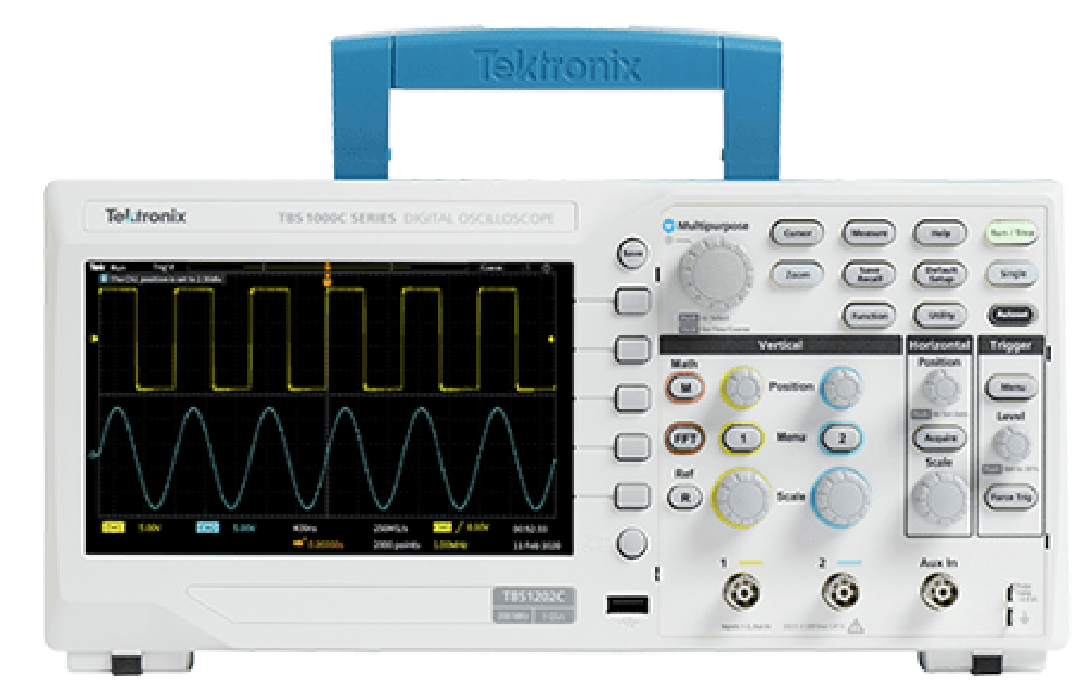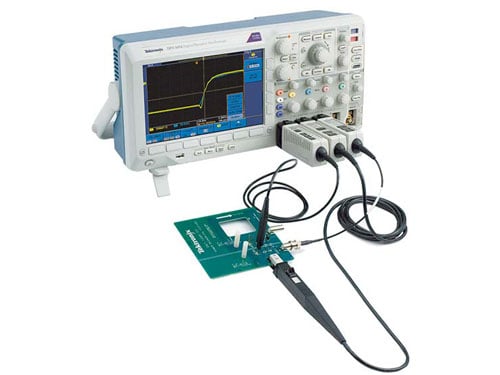

An oscilloscope, formerly known as an oscillograph (informally scope, oscope, or o-scope), is an instrument that graphically displays electrical signals and shows how those signals change over time. It measures these signals by connecting with a sensor, which is a device that creates an electrical signal in response to physical stimuli like sound, light and heat. For instance, a microphone is a sensor that converts sound into an electrical signal.
Here we’ll cover everything you need to know about an oscilloscope from how it works to how to find the right one.
What is an oscilloscope used for?
Oscopes are often used when designing, manufacturing or repairing electronic equipment. Engineers use an oscilloscope to measure electrical phenomena and solve measurement challenges quickly and accurately to verify their designs or confirm that a sensor is working properly.
Who uses an oscilloscope?
Scientists, engineers, physicists, repair technicians and educators use oscilloscopes to see signals change over time. An automotive engineer might use an oscilloscope to correlate analog data from sensors with serial data from the engine control unit. Meanwhile, a medical researcher might use an oscilloscope to measure brain waves. There is no shortage of applications for this powerful instrument.
How does an oscilloscope work?
There are three primary oscilloscope systems: vertical, horizontal and trigger systems. Together, these systems provide information about the electrical signal, so the oscilloscope can accurately reconstruct it. The picture below shows the block diagram of an oscilloscope.

The first stage attenuates or amplifies the signal voltage in order to optimize the amplitude of the signal; this is referred to as the vertical system since it depends on the vertical scale control. Then the signal reaches the acquisition block, where the analog-to-digital converter (ADC) is used to sample the signal voltage and convert it in a digital format value. The horizontal system, which contains a sample clock, gives each voltage sample a precise time (horizontal) coordinate. The sample clock drives the ADC and its digital output is stored in the acquisition memory as a record point. The trigger system detects a user-specified condition in the incoming signal stream and applies it as a time reference in the waveform record. The event that met the trigger criteria is displayed, as is the waveform data preceding or following the event.
Explore Our Selection
What does an oscilloscope measure?
Simply put, an oscilloscope measures voltage waves. On an oscilloscope screen, voltage is displayed vertically on the Y axis and time is represented horizontally on the X axis. The intensity or brightness of the display is sometimes called the Z axis. The resulting graph can tell you many things about a signal, including:

- Time and voltage values of a signal
- Frequency of an oscillating signal
- The “moving parts” of a circuit represented by the signal
- Frequency with which a particular portion of the signal is occurring relative to other portions
- Whether or not a malfunctioning component is distorting the signal
- How much of a signal is direct current (DC) or alternating current (AC)
- The portion of the signal that is noise
- Whether noise is changing over time
Oscilloscope vs. digital multimeter vs. voltmeter
Oscilloscope, digital multimeter, voltmeter—what’s the difference and are they interchangeable? A voltmeter measures the potential difference between two nodes on an electrical circuit. Though a digital multimeter also measures voltage, it can measure current and resistance as well. And an oscilloscope shows how the voltage changes over time. Typically, as the application becomes more advanced, so does the instrument.
Types of oscilloscopes
There are two types of oscilloscopes: analog and digital. An analog oscilloscope captures and displays the voltage wave form in its original form, while a digital oscilloscope uses an analog-to-digital converter to capture and store information digitally. When it comes to debugging and design, most engineers today use digital oscilloscopes. Digital oscilloscopes generally fall into five categories, ranging from the less expensive general-purpose oscilloscopes to more complex oscilloscopes that, while more expensive, offer advanced functionality and greater accuracy than the more basic models.
- Digital storage oscilloscope (DSO): This is a conventional digital oscilloscope and is ideal for low repetition-rate or single-shot, high-speed, multichannel design applications.
- Digital phosphor oscilloscope (DPO): A DPO takes a new approach to oscilloscope architecture and, unlike DSOs, provides Z-axis (intensity) in real-time. DPOs are the best general-purpose design and troubleshooting tool for a wide range of applications and are often used for advanced analysis, communication mask testing, digital debug of intermittent signals, repetitive digital design and timing applications.
- Mixed signal oscilloscope (MSO): A type of DSO, MSOs are designed to display and compare both analog and digital signals. It is the instrument of choice for quickly debugging digital circuits using powerful digital triggering, high-resolution acquisition capability and analysis tools.
- Mixed domain oscilloscope (MDO): These oscilloscopes provide the same capabilities as mixed signal oscilloscopes, but also offer a built-in spectrum analyzer, adding RF debugging to the analog and digital capabilities.
- Digital sampling oscilloscope: For very high-speed signal analysis, sampling oscilloscopes support jitter and noise analysis with ultra-low jitter acquisitions. It can achieve bandwidth and high-speed timing 10 times higher than other oscilloscopes for repetitive signals.
Read more about the types of oscilloscopes and the features of each to find the right oscilloscope for your application.
How to choose the best oscilloscope
When it comes to choosing the right oscilloscope, there are a number of factors to consider, including bandwidth, waveform capture rate, sample rate, rise time, triggering capabilities and price. Much like shutter speed, lighting conditions and aperture of a camera all affect its ability to capture an image clearly and accurately, the performance considerations of an oscilloscope significantly affect its ability to achieve the required signal integrity. To learn more about these criteria and how they might relate to your applications, read our deep dive on how to evaluate an oscilloscope.
History of the oscilloscope
In 1897, a German physicist named Karl Ferdinand Braun invented a cathode ray tube and, along with it, the first oscilloscope, which was expanded upon decades later by the company A. C. Cossor. In 1934, the first commercial oscilloscope was released by General Radio, and it became the first to be used outside of a laboratory. And in 1946, Howard Vollum and Melvin Jack Murdock founded Tektronix, which has gone on to become a world leader oscilloscopes. Since then, Tek has continued releasing innovative new technologies, including the first digital oscilloscope in 1971 and the first oscilloscope-to-cloud software solution—TekDrive—in 2020. Oscilloscopes are a staple of any engineer’s bench and have even been featured in famous films throughout history. You can visit the Tek museum website to see a complete list of oscilloscopes in films.
Oscilloscope resources
Digital oscilloscopes are the key to helping engineers meet today's demanding measurement challenges. Tektronix is the world leader in oscilloscopes and offers a variety of oscilloscopes to meet the needs of even the most advanced applications. Shop oscilloscopes today or contact a Tektronix representative to request an oscilloscope demo.
Not ready to "pull the trigger”? Download our XYZs of Oscilloscopes primer to learn everything you need to know in order to choose and use the best oscilloscope for your application.







